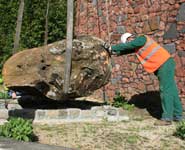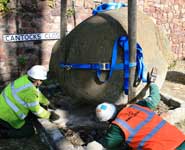When St Anne’s Park station closed in 1970, the stones remained on the disused platform until Sir Alfred Pugsley, then Emeritus Professor of Engineering, secured one of them for the University. It was transported to a patch of lawn on Woodlands Road under the supervision of Professor Roy Severn (now Emeritus Professor) in Civil Engineering.
Thanks to the efforts of Bob Hughes, a former member of staff at the University’s Long Ashton Research Station, discussions with Network Rail have led to the arrival of the second stone. The pair have now been installed on the raised bed at the entrance to Cantock’s Close and new signs will be erected to explain these remarkable geological features.

